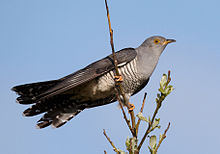Cuculus canorus
| Common cuckoo | |
|---|---|
 |
|
| Scientific classification | |
| Kingdom: | Animalia |
| Phylum: | Chordata |
| Class: | Aves |
| Order: | Cuculiformes |
| Family: | Cuculidae |
| Genus: | Cuculus |
| Species: | C. canorus |
| Binomial name | |
|
Cuculus canorus Linnaeus, 1758 |
|
 |
|
| Range of Cuculus canorus Deep purple : Summer range (Breeding) Pink : Winter range (Nonbreeding) |
|
The common cuckoo (Cuculus canorus) is a member of the cuckoo order of birds, Cuculiformes, which includes the roadrunners, the anis and the coucals.
This species is a widespread summer migrant to Europe and Asia, and winters in Africa. It is a brood parasite, which means it lays eggs in the nests of other bird species, particularly of dunnocks, meadow pipits, and reed warblers. Although its eggs are larger than those of its hosts, the eggs in each type of host nest resemble the host's eggs. The adult too is a mimic, in its case of the sparrowhawk; since that species is a predator, the mimicry gives the female time to lay her eggs without being seen to do so.
The species' binomial name is derived from the Latin cuculus (the cuckoo) and canorus (melodious; from canere, meaning to sing). The cuckoo family gets its common name and genus name by onomatopoeia for the call of the male common cuckoo. The English word "cuckoo" comes from the Old French cucu and it first appears about 1240 in the poem Sumer Is Icumen In - "Summer has come in / Loudly sing, Cuckoo!" in modern English.
The scientific name is from Latin. Cuculus is "cuckoo" and canorus, "melodious ".
...
Wikipedia

